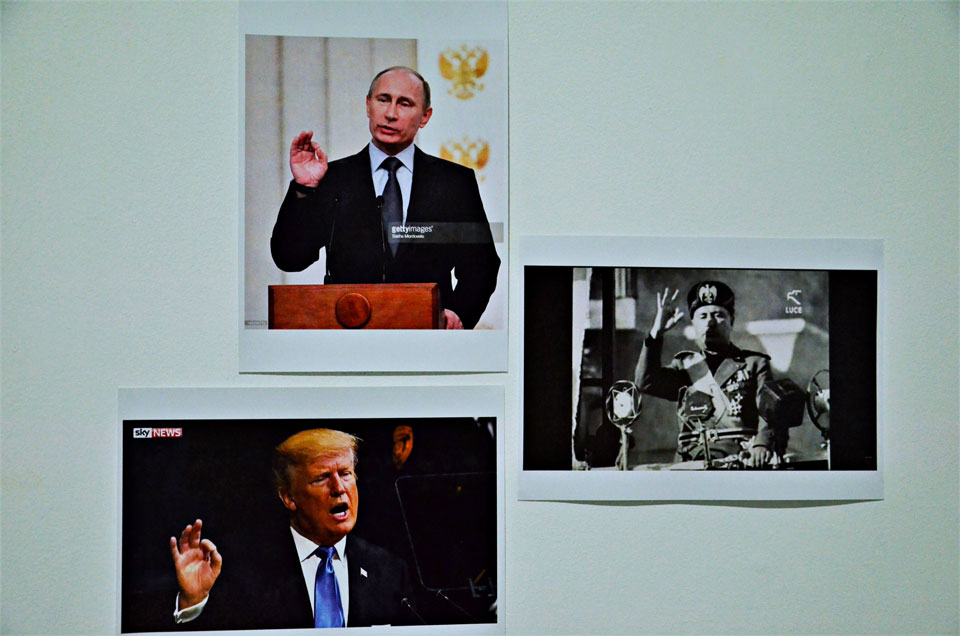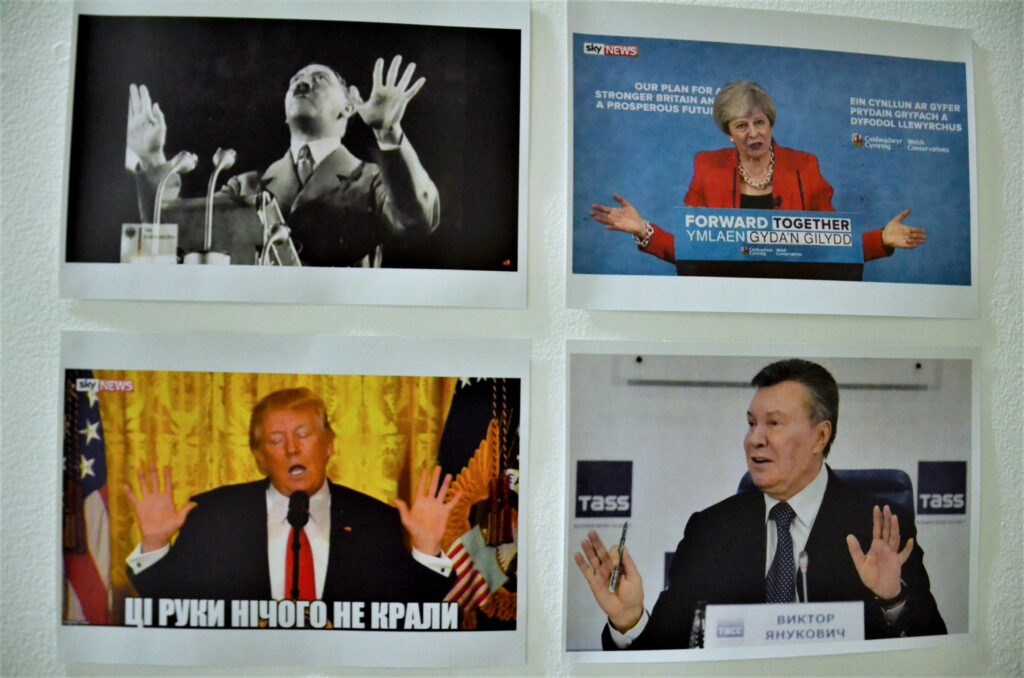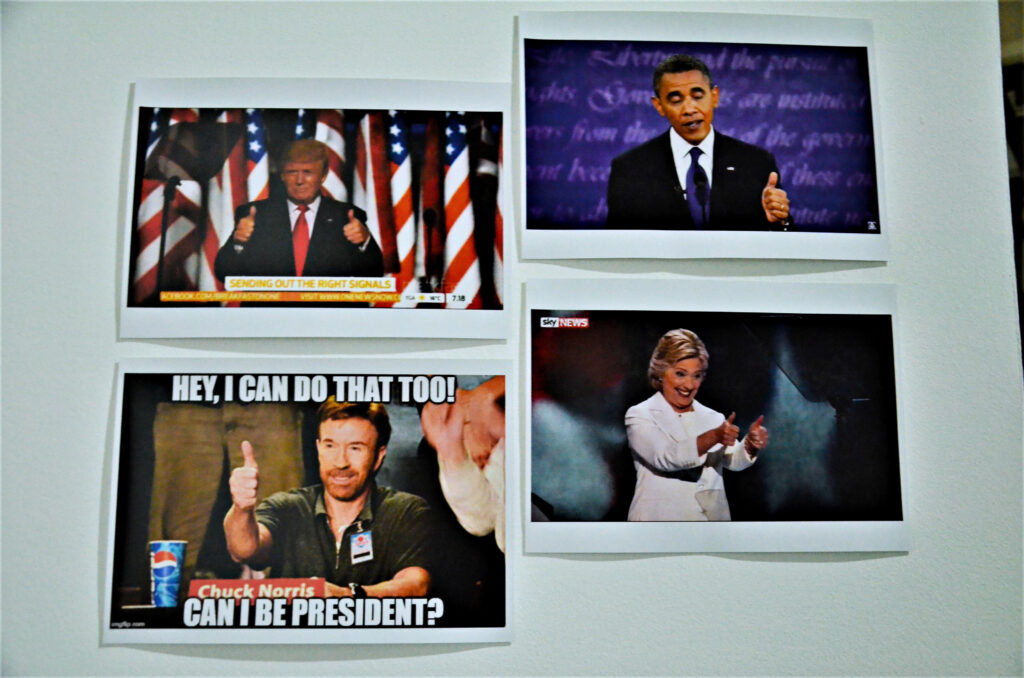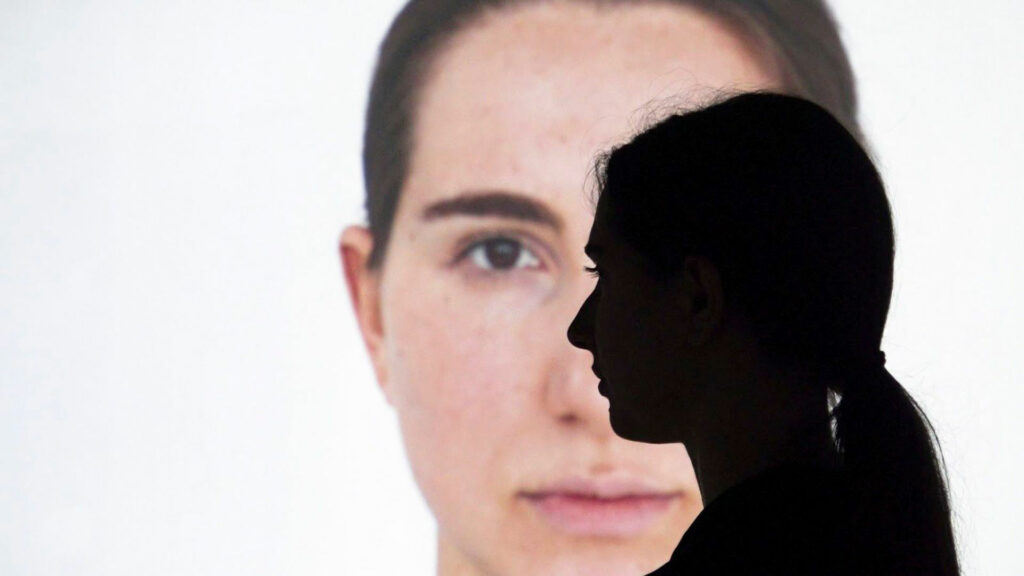2018
Residency INKUBATOR’18 at Tanzfaktur
Cologne
In contrast to physical violence that often leaves bruises and scars, symbolic violence works through words and symbols, making it harder to detect and recognize as such.
Karen Morgan
“Study #1” is an installation-performance in which Yana Novotorova and Charlotte Triebus are reflecting on the modes and mechanisms of social and personal domination, referring to the military system with its strict codes of conduct. Taking military drill with its basic positions as a starting point, the artists create a situation of a fictional training session that aims at instructing people on how to become “proper citizens”. In this session members of the audiens are being told how to breath, blink and swallow “properly” – the only three actions that one is allowed to do while standing in the military position of attention.
The installation consists of four projections, an audio layer and live performance. The projections are beamed on the four walls of the space, each of them containing the faces of the performers gazing at the audience. The audio layer breaks down the processes of breathing, blinking and swallowing to precise, minuscule actions, giving directives on how to execute those actions “properly”, for example: “To breath in, first contract your diaphragm and move it down. Then suck the air in through your nostrils.” The performers themselves are in the space, facing one of the projections, being subjected to the commands themselves – ultimate internalization of the outer control mechanisms.
The human body was entering a machinery of power that explores it, breaks it down and rearranges it. A ‚political anatomy‘, which was also a mechanics of power‘ was being born; it defined how one may have a hold over other’s bodies, not only so that they might do what one wishes, but so that they may operate as one wishes, with the techniques, the speed and the efficiency that one determines.
Michel Foucault
How did your research on symbolic violence begin?
YN: I started researching symbolic violence in 2018 in the context of the INKUBATOR residency at Tanzfaktur in Cologne. At that time I collaborated with the media artist Charlotte Triebus. At the beginning of the residency we invested time into studying the theoretical framework of the subject at hand, laid out by thinkers like P. Bourdieu, M. Foucault, Hannah Arendt, and others.
Soon enough we realised how immensely vast and complex the subject was. The residency at Tanzfaktur consisted of three phases, so we subdivided the research process according to some of the contexts in which the workings of symbolic power and violence could be observed: military and political systems, public space and conflict affected areas, dance and physical education. This is where the idea of “studies” came in. The research resulted in several performative sketches that had an installative charakter.



What is it you wanted to achieve through this installation?
YN: While researching symbolic violence of the language and its relationship to the body, we could not help but notice how it relies on direct verbal commands that are being given and have to be executed without much thought or hesitation. Of course, it is most extreme when it comes to the military, however, it works in a similar way in ballet, as well as many other dance techniques, yoga, or sports. We wanted to bring attention to the status quo of this agreement by creating an exaggerated, grotesque situation in which one is being taught how to perform the most basic bodily functions, those that we normally don’t control and hardly notice – breathing, blinking and swallowing. The interesting thing is that once one has been made aware of those processes through detailed instructions on how to perform them, the natural rhythm and the automaticity is completely messed up. We really liked this effect for two reasons: first, it shows how, even if you don’t intend to play along, once you hear those commands, you cannot help the effect they have on you….unless you close your ears, of course; secondly, it makes tangible the processes that normally run undetected in our bodies – much like symbolic violence mostly runs undetected in our society.
While an individual may be able to decode the relevant signals and to understand their veiled social meaning, this is without recognizing them consciously as what they are – namely as words, gestures, movements and intonations of domination.
B. Krais, Gender and Symbolic Violence
What did you research during the 2nd phase of your INKUBATOR residency at Tanzfaktur and what was the outcome?
YN: During the second phase of the residency we focused on studying symbolic violence in the political context. We looked closely at political speech, since it is the main tool through which politicians have been coercing the masses into submissions since time immemorial. It’s no secret that most politicians go through training to learn how to most effectively influence people while giving a public speech. There appears to be almost a uniform body language that is meant to help those striving to seize or maintain power influence people on a subconscious level. There are plenty of youtube tutorials that explain in detail, what each gesture is supposed to mean: for example, if someone brings both hands to the heart area, it is supposed to give an impression that they care. Many of us do it subconsciously in everyday life as well, however, in the political realm, certain words, gestures, movements and intonations become an instrument of domination.
In the end of this research phase we presented an image installation that consisted of snapshots of different politicians while they were giving a speech. The images were juxtaposed according to a particular gesture performed by different politicians to emphasize the striking similarity in the body language. The juxtaposition, decontextualisation and repetition of one gesture helped us strip it of its symbolic meaning, unveiling it at the same time.
As a second step, we created a performative situation of a fictional political speech. This fake political figure, played by me, gave a campaign speech, using those cliché gestures, while at the same time commenting on their effects:
“Now I will shake your hand, pretending that I know you: this will make me more relatable”
At the same time, we tried playing with a dissensus of the gestures and what was actually being said. For instance, when this figure said: “….I care so much about the prosperity of our country”, she made a gesture signifying “a little” (brining thumb and index finger together), and so on.
The whole thing was accompanied by a funny powerpoint presentation, including pictures like the one below, making the whole thing into a hybrid of a performance and stand-up comedy – a format that we have further developed and used during the production of “Studies On Symbolic Violence Vol.I”. Unfortunately, there is no documentation of this performance, since the data was lost in an accident.
Supported by the Tanzfaktur Cologne and event center Tor 28.

